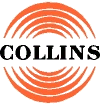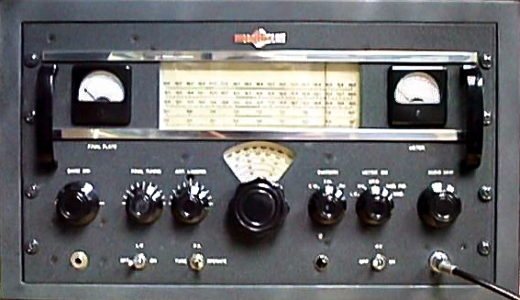History
Arthur Collins founded Collins Radio Company in 1933 in Cedar Rapids, Iowa. It designed and produced both shortwave radio equipment and equipment for the burgeoning AM Broadcast industry. Collins was solicited by the military, the scientific community and by the larger AM radio stations for special equipment. Collins supplied the equipment to establish a communications link with the South Pole expedition of Rear Admiral Richard Byrd in 1933.
 In the post war years, the Collins Radio Company expanded its work in all phases of the communications field while broadening its technology. This moved Arthur Collins into a more active role as CEO guiding department leaders holding significant responsibilities. New developments such as flight control instruments, radio communication devices and satellite voice transmissions created great opportunities in the marketplace. Collins Radio Company provided communications for the United States' role in the Space Race, including equipment for astronauts to communicate with earth stations and equipment to track and communicate with spacecraft. Collins communications equipment was used for Projects Mercury, Gemini and Apollo, providing voice communication for every American astronaut traveling through space. In 1973, the U.S. Skylab Program used Collins equipment to provide communication from the astronauts to earth.
In the post war years, the Collins Radio Company expanded its work in all phases of the communications field while broadening its technology. This moved Arthur Collins into a more active role as CEO guiding department leaders holding significant responsibilities. New developments such as flight control instruments, radio communication devices and satellite voice transmissions created great opportunities in the marketplace. Collins Radio Company provided communications for the United States' role in the Space Race, including equipment for astronauts to communicate with earth stations and equipment to track and communicate with spacecraft. Collins communications equipment was used for Projects Mercury, Gemini and Apollo, providing voice communication for every American astronaut traveling through space. In 1973, the U.S. Skylab Program used Collins equipment to provide communication from the astronauts to earth.
Broadcast transmitters
In the mid-1930s, the Collins Radio Company constructed and sold transmitters and audio mixing consoles to the broadcast industry. Collins remained an important manufacturer of AM and FM broadcast radio transmitters for the commercial market surviving the drastic cost cutting market of the 1960s and 1970s. The transmitter line was later sold to Continental Electronics, which continued to produce a number of Collins designs under its own nameplate before phasing them out in the 1980s.
Shortwave transmitters
Collins produced several shortwave transmitters to the commercial market. A "30" Series production catered to the growing need of state highway patrol agencies and Department of Commerce aviation needs. During World War II, Collins produced high power transmitters for aircraft, notably the ART-13 equipped with automatic tuning circuits, which represented an important enhancement for airborne radio communications.
The United States Coast Guard Cutter USCGC Courier was employed as seagoing relay station for Voice of America programming using two Collins 207B-1 transmitters. Amateur radio transmitters included the 32V-1, -2, and -3, KWS-1 and the rack mounted KW-1.
Receivers
Around 1947, the company introduced their first amateur radio receiver, the 75A-1 (called the 75A). This set achieved excellent stability for the time due to high build quality and the use of a permeability tuned oscillator (PTO) in its second conversion stage. It was one of the few double conversion superheterodynes on the market and covered only the amateur bands.
With the experience gained in the design of the 75A-1, Collins released the 51J-1 receiver, a general coverage HF set covering .5 to 30 MHz. It would be produced in somewhat updated versions (51J-2, 51J-3, 51J-4) for about a decade. It was known as the R-388 and was used in multiple receiver diversity RTTY installations.
The 75A amateur line was updated throughout the early 50s, finishing with the 75A-4, which was released in 1955. The Collins mechanical filter was introduced to consumers in the 75A-3, and the 75A-4 was one of the first receivers marketed specifically as a single sideband receiver.
Transceivers and Systems
 With the introduction of the S-Line in 1958, Collins moved from designing individual products that could be used together, to ones that were designed to integrate and operate together, in various combinations, as a system. They were the first equipment maker to take this approach. Collins was also the first to introduce a compact HF transceiver, the KWM-1, the year before. Together, these two innovations put Collins temporarily ahead of its competition and set the stage for other manufacturers and the next generation of amateur (and military) HF radio equipment.
With the introduction of the S-Line in 1958, Collins moved from designing individual products that could be used together, to ones that were designed to integrate and operate together, in various combinations, as a system. They were the first equipment maker to take this approach. Collins was also the first to introduce a compact HF transceiver, the KWM-1, the year before. Together, these two innovations put Collins temporarily ahead of its competition and set the stage for other manufacturers and the next generation of amateur (and military) HF radio equipment.
 The photo to the right shows The 75S-1 receiver and 32S-1 transmitter, comprising the heart of the S-Line, operated separately or together to transceive. The units included a new compact PTO design that provided stable, highly linear tuning across 200 kHz band segments. The S-Line tuning dial mechanism was unique when introduced. It used concentric dials and a gear mechanism that provided precise dial resolution, better than 1 kHz.
The photo to the right shows The 75S-1 receiver and 32S-1 transmitter, comprising the heart of the S-Line, operated separately or together to transceive. The units included a new compact PTO design that provided stable, highly linear tuning across 200 kHz band segments. The S-Line tuning dial mechanism was unique when introduced. It used concentric dials and a gear mechanism that provided precise dial resolution, better than 1 kHz.
Collins S-Line ➙ circa 1969
Within a few years Collins had introduced additional S-Line components. The KWM-2 transceiver replaced the KWM-1 using many of the S-Line's design features and matching its styling. Collins continued to improve the S-Line and continued to produce the S-Line well into the late 1970s and after its acquisition by Rockwell.
In 1978, with the move to solid state design, the S-Line came to an end after a two decade production run. The KWM-380 transceiver was introduced the next year ➙ a break with the past both in its use of transistors and digital technology, and its styling. It would be Collins' final entry in the amateur radio market until it was discontinued in the mid-1980s.
 Links Related To Collins Radio (Pages open in new browser window)
Links Related To Collins Radio (Pages open in new browser window)
- Collins Radio Association ➙ The Collins Radio Association was established to encourage hams, especially the newcomer, to share the enjoyment that comes from owning and operating Collins equipment, the best amateur radio gear in the world!
- The WA3KEY Virtual Collins Radio Museum ➙ If it's not here, it's probably not anywhere!
- The R-390A FAQ page.

- The Rockwell−Collins web site ➙ See what Collins is up to these days
 Pictures
Pictures
 Return to Radio Pictures
Return to Radio Pictures
 Return to MCRN Home
Return to MCRN Home






![]() Excerpts from Wikipedia (page opens in new browser window)
Excerpts from Wikipedia (page opens in new browser window)
 In the post war years, the Collins Radio Company expanded its work in all phases of the communications field while broadening its technology. This moved Arthur Collins into a more active role as CEO guiding department leaders holding significant responsibilities. New developments such as flight control instruments, radio communication devices and satellite voice transmissions created great opportunities in the marketplace. Collins Radio Company provided communications for the United States' role in the Space Race, including equipment for astronauts to communicate with earth stations and equipment to track and communicate with spacecraft. Collins communications equipment was used for Projects Mercury, Gemini and Apollo, providing voice communication for every American astronaut traveling through space. In 1973, the U.S. Skylab Program used Collins equipment to provide communication from the astronauts to earth.
In the post war years, the Collins Radio Company expanded its work in all phases of the communications field while broadening its technology. This moved Arthur Collins into a more active role as CEO guiding department leaders holding significant responsibilities. New developments such as flight control instruments, radio communication devices and satellite voice transmissions created great opportunities in the marketplace. Collins Radio Company provided communications for the United States' role in the Space Race, including equipment for astronauts to communicate with earth stations and equipment to track and communicate with spacecraft. Collins communications equipment was used for Projects Mercury, Gemini and Apollo, providing voice communication for every American astronaut traveling through space. In 1973, the U.S. Skylab Program used Collins equipment to provide communication from the astronauts to earth.
 With the introduction of the S-Line in 1958, Collins moved from designing individual products that could be used together, to ones that were designed to integrate and operate together, in various combinations, as a system. They were the first equipment maker to take this approach. Collins was also the first to introduce a compact HF transceiver, the KWM-1, the year before. Together, these two innovations put Collins temporarily ahead of its competition and set the stage for other manufacturers and the next generation of amateur (and military) HF radio equipment.
With the introduction of the S-Line in 1958, Collins moved from designing individual products that could be used together, to ones that were designed to integrate and operate together, in various combinations, as a system. They were the first equipment maker to take this approach. Collins was also the first to introduce a compact HF transceiver, the KWM-1, the year before. Together, these two innovations put Collins temporarily ahead of its competition and set the stage for other manufacturers and the next generation of amateur (and military) HF radio equipment.
 The photo to the right shows The 75S-1 receiver and 32S-1 transmitter, comprising the heart of the S-Line, operated separately or together to transceive. The units included a new compact PTO design that provided stable, highly linear tuning across 200 kHz band segments. The S-Line tuning dial mechanism was unique when introduced. It used concentric dials and a gear mechanism that provided precise dial resolution, better than 1 kHz.
The photo to the right shows The 75S-1 receiver and 32S-1 transmitter, comprising the heart of the S-Line, operated separately or together to transceive. The units included a new compact PTO design that provided stable, highly linear tuning across 200 kHz band segments. The S-Line tuning dial mechanism was unique when introduced. It used concentric dials and a gear mechanism that provided precise dial resolution, better than 1 kHz.
![]() Links Related To Collins Radio (Pages open in new browser window)
Links Related To Collins Radio (Pages open in new browser window)
![]()
![]() Pictures
Pictures
















![]() Return to Radio Pictures
Return to Radio Pictures
![]() Return to MCRN Home
Return to MCRN Home